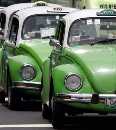
![]()
It's Time to Say Adios to Beetle 'Love Bug'
Tue July 8, 2003
|
|
PUEBLA, Mexico (Reuters) - The end is nearing for the old Volkswagen Beetle, the much-loved Love Bug which will shortly go the way of other flower power-era icons like kaftans and The Doors.
On Thursday, Volkswagen's plant in Mexico -- the only one in the world which still makes the old-style Beetle -- launches one last retro edition of the plucky bug before bringing down the curtain on nearly 70 years of history.
The "people's car" that was first commissioned by Nazi dictator Adolf Hitler and went on to become a symbol of the hippie revolution will almost certainly be put to rest for good by the end of the month, according to the company.
"There has never been a car like it, but I don't think production will go on beyond" the end of July, said Christine Kuhlmeyer, head of corporate communication at Volkswagen in Mexico.
From Iceland to Malaysia, the original Beetle has attracted devoted fans like no other car. A redesigned, sleeker version called the New Beetle was launched in 1998 but at a price of $20,000 to $25,000 is no longer an everyman's car.
George Memetov, who started up the Classic Beetle Club in the Belarus capital Minsk, considers owners of the original air-cooled, rear-engine vehicle to be a special breed.
"It's a certain type of person who drives a Beetle. All people who have Beetles are very open to ideas; they love life," he told Reuters by telephone.
For the 300 Mexicans who work on the Beetle production line at the plant in the central Mexican state of Puebla, it will be like parting with a member of the family. The factory will continue producing the New Beetle.
"It's a jewel for me. The little bug has given my family prosperity," said Armando Pasillas, 60, who has worked for 37 years on the Beetle, which has been made in Mexico since 1964.
"I like seeing them in the street because I know they have all passed through my hands," he said. "I've left part of my life here," he added.
In 1996, Mexico became the last country to produce the old Beetle and since 1998 the car has only been sold in Mexico. The Volkswagen plant in Puebla is also the only one worldwide to produce the New Beetle and that is mainly for export.
Beetle fans on the Internet swap tales of wacky stunts like successfully "sailing" across New York harbor in a Beetle fitted with a propeller in 1960.
Another Web site recounts how by tampering with the Beetle's fuel tank, East Germans made enough space to hide a person and that way managed to sneak around 50 people to the other side of the Berlin Wall before its fall in 1989.
A BREED APART
The Love Bug was conceived in the early 1930s out of Hitler's desire to produce a cheap, durable Volkswagen (literally "people's car" in German) for the German family.
The chubby, curvy little car took off after World War II, quickly becoming a symbol of the German economic miracle.
As its popularity spread, the Beetle became the car of choice of the rebellious post-war generation in the United States and Europe, for whom it represented freedom from the tight social restrictions of the time.
The Beetle sealed its cult status as the star of Disney's series of Herbie films, such as "Herbie Goes To Monte Carlo."
In Mexico alone, there are 90 fan clubs and around 1.5 million Beetles in circulation.
In Mexico City, the bug, or "vocho" as it is known locally, is a stalwart. Painted white and green, it is the standard model used by taxi drivers to crawl through heavy traffic.
U.S. fan Rick Mortensen was so taken with the curvy car that in 1985 he started the Bug-O-Rama, an annual race and get-together for Beetle fans in Phoenix, Arizona.
Beetle owner Paul Cahill holds the record for the longest ownership of one car, according to the Guinness Book of Records. He bought a bug in 1961 in Australia and has driven it every day since then, clocking up 310,700 miles.
But all good things must come to an end. And when sales almost halved from 2000 to 2002 to 24,500 cars, Volkswagen decided to pull the plug on the legend.
New technology spawned a range of compact, efficient and fast cars like the Fiat Uno and Ford Fiesta that edged the Beetle out of the market.
"At the end of the day, it's the customer who decides," said Volkswagen's Kuhlmeyer.
A decision by Mexico City's government to only give out future permits to taxis with four-doors helped seal the two-door bug's fate.
In its heyday, over 1 million Beetles were produced annually worldwide. Yet over the course of the years, the bug's basic design hardly changed.
"One thing is sure: the Beetle never will disappear from the roads of our planet and, above all, it never will disappear from the hearts of millions of people all over the world," said Italian fan Mattia Zamana.
/ Document saved from http://www.reuters.com /